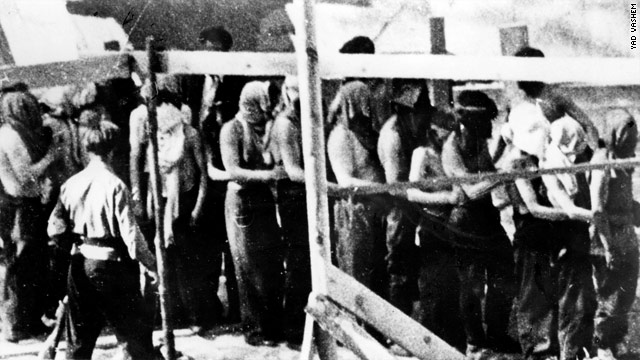Editor's note: CNN's Gena Somra and Farhad Shadravan traveled to Lithuania with Efraim Zuroff in November 2008, reporting on his journey and producing the video in this piece. Below are excerpts only. Press here to go to the full article in CNN.
... [Efraim Zuroff, Israel director of The Simon Wiesenthal Center] ...says ...Lithuania is trying to rewrite Holocaust history. "Nowhere in the world...has a government gone to such lengths to obscure their role in the Holocaust. ... Their mission is to change the history of the Holocaust to make themselves blameless."
Lithuania and the Nazis
Within five months of Nazi Germany's invasion in the summer of 1941, most of Lithuania's 200,000 to 220,000 Jews were dead -- shot and left in massive sand pits and mass graves along with thousands of ethnic Poles, the mentally ill and others. By the end of the war, the percentage of Jews killed in Lithuania -- 90 to 96 percent -- was as high or higher than anywhere else in Europe.
"And the question is, 'Why were the numbers so high?' ...because of the help of the local population -- of the Lithuanians."
A Lithuanian Militia Leads a Group of Jews to their Execution
The pace of the mass murder of Lithuania's Jews -- and the active participation of the local population -- are meticulously recorded in two of the most infamous documents of Holocaust history.
The Jaeger Report, written by Karl Jaeger, the SS commander of a Nazi killing unit that operated around Vilnius, Lithuania, is a matter-of-fact account of those killed each day under his command.
September 1, 1941, a typical entry, lists those killed for the day as: "1,404 Jewish children, 1,763 Jews, 1,812 Jewesses, 109 mentally sick people, one German woman who was married to a Jew, and one Russian woman."
In the report, Jaeger notes the "essential" help of local Lithuanians and says 4,000 Jews were "liquidated by pogroms and executions," exclusively by Lithuanian partisans. The final count of those murdered starting in the summer of 1941 and ending in November of that year is 133,346 -- the vast majority of them Jews.
...The Nazis arrived after a year of occupation by the Soviet Union that was so brutal that many Lithuanians welcomed the Nazis when they arrived in June 1941.
Nazi propaganda painted local Jews as communists in league with the Soviets, stoking existing local anti-Semitism, and prompting the provisional government in Lithuania, and thousands of Lithuanians, to help facilitate the Nazi policy of liquidating the local Jewish population...
..."It will be impossible for Lithuania to come to terms with its history ... until the country's elite admits that the provisional government of Lithuania in 1941 collaborated with the Nazis and acted against Lithuanian citizens. Unfortunately, the provisional government ... is praised up to the skies in Lithuania....It is a disgrace."
For Zuroff, Lithuania missed its best opportunity for catharsis by failing to punish even one of its own citizens for Holocaust crimes.
"The Lithuanians squandered the best chance they had to get that burden of guilt off of them. And now it's going to take them 100 years to get rid of it. The only way they will succeed is through education, documentation, research -- and a lot of pain."
In August, the Wiesenthal Center will release its 2010 Annual Report on the Worldwide Investigation and Prosecution of Nazi War Criminals.


No comments:
Post a Comment